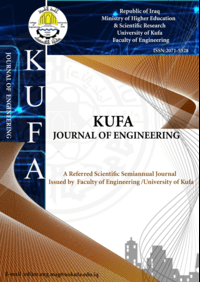SYNTHESIS AND CHARACTERISATION OF DIELECTRIC COMPOSITES PRODUCED FROM GLYCINE AND ALKALINE NIOBATE-BASED CERAMICS
DOI:
https://doi.org/10.30572/2018/kje/150106Keywords:
Glycine, Composites, KNNLST Ceramics, Amino acid, DielectricAbstract
Glycine exhibits a little piezoelectric response when poled, while lead-free alkaline niobate-based ceramics show much higher responses. This research investigates the synthesis of a dielectric composite from a combination of glycine and (K0.45Na0.51Li0.04) (Nb0.85Ta0.1Sb0.04) O3 (KNNLST) ceramics. The mixed oxide ceramics synthesis method was used to produce the ceramics, while glycine powder was commercially procured. The composition range of the shaped and heat-treated composites is from no ceramics to 100 wt.% ceramics content. X-ray diffraction (XRD), Scanning Electron Microscopy (SEM), dielectric studies, and hysteresis measurements were used to characterize the samples. The obtained phases transformed from the monoclinic phase in glycine to a two-phase orthorhombic-tetragonal phase in the ceramics. The samples’ morphology revealed a dense microstructure with some cracks, large porosity, and smaller grain sizes. The dielectric properties showed increasing dielectric constant and loss values with increasing ceramics content, while the ac conductivity also increased with rising ceramics content. Improving the range of ceramics led to polarization hysteresis graphs indicating ferroelectricity in the samples. The properties of the composites show they can be used in electromechanical devices.
Downloads
References
Abdullah, A. M., Sadaf, M. U. K., Tasnim, F., Vasquez, H., Lozano, K. & Uddin, M. J. (2021) Knn Based Piezo-Triboelectric Lead-Free Hybrid Energy Films. Nano Energy, 86, 1-43. https://doi.org/10.1016/j.nanoen.2021.106133. DOI: https://doi.org/10.1016/j.nanoen.2021.106133
Bhat, M. N. & Dharmaprakash, S. M. (2002) Growth Of Nonlinear Optical Γ -Glycine crystals. Journal of Crystal Growth, 236, 376–380. https://doi.org/10.1016/S0022-0248(01)02094-2 DOI: https://doi.org/10.1016/S0022-0248(01)02094-2
Bishara, H., Nagel, A., Levanon, M. & Berger, S. (2020) Amino Acids Nanocrystals for piezoelectric detection of ultra-low mechanical pressure. Materials Science & Engineering C, 108, 1-7. https://doi.org/10.1016/j.msec.2019.110468 DOI: https://doi.org/10.1016/j.msec.2019.110468
Boldyreva, E. V., Drebushchak, V. A., Drebushchak, T. N., Paukov, I. E., Kovalevskaya, Y. A. & Shutova, E. S. (2003a) Polymorphism of Glycine Thermodynamic aspects. Part II. Polymorphic transitions. Journal of Thermal Analysis and Calorimetry, 73, 419–428. https://doi.org/10.1023/A:1025457524874 DOI: https://doi.org/10.1023/A:1025457524874
Boldyreva, E. (2021) Glycine: The Gift That Keeps On Giving. Isr. J. Chem., 61, 828 – 850 DOI: https://doi.org/10.1002/ijch.202100103
Broadhurst, E. T., Xu, H., Clabbers, M. T. B., Lightowler, M., Nudelman, F., Zou, X. & Parsonsa, S. (2020) Polymorph evolution during crystal growth studied by 3D electron diffraction. IUCrJ, 7, 5–9. https://doi.org/10.1107/S2052252519016105 DOI: https://doi.org/10.1107/S2052252519016105
Genchi, G. G., Ceseracciu, L., Marino, A., Labardi, M., Marras, S., Pignatelli, F., Bruschini, L., Mattoli, V. & Ciofani, G. (2016) P(Vdf-Trfe)/BaTiO3 Nanoparticle Composite Films Mediate Piezoelectric Stimulation and Promote Differentiation of SH-SY5Y Neuroblastoma Cells. Adv. Healthcare Mater., 5, 1808–1820. https://doi:10.1002/adhm.201600245 DOI: https://doi.org/10.1002/adhm.201600245
GUERIN, S. (2022) Getting the Lead Out: Biomolecular Crystals as Low-Cost, HighPerformance Piezoelectric Components. Acc. Mater. Res., 3, 782−784. https://doi.org/10.1021/accountsmr.2c00124 DOI: https://doi.org/10.1021/accountsmr.2c00124
Guerin, S., Stapleton, A., Chovan, D., Mouras, R., Gleeson, M., Mckeown, C., Noor, M. R., Silien, C., Rhen, F. M. F., Kholkin, A. L., Liu, N., Soulimane, T., Tofail, S. A. M. & Thompson, D. (2018) Control of piezoelectricity in amino acids by supramolecular packing. Nature Materials 17, 180-188. https://doi:10.1038/NMAT5045 DOI: https://doi.org/10.1038/nmat5045
GUERIN, S., TOFAIL, S. A. M. & THOMPSON, D. (2019) Organic piezoelectric materials: milestones and potential. NPG Asia Materials 10, 11, 1-5. https://doi.org/10.1038/s41427-019-0110-5 DOI: https://doi.org/10.1038/s41427-019-0110-5
Hosseini, E. S. & Dahiya, R. (2020) Biodegradable Amino acid-based Pressure Sensor. IEEE, 1-4. https://doi:10.1109/SENSORS47125.2020.9278878. DOI: https://doi.org/10.1109/SENSORS47125.2020.9278878
Hosseini, E. S., Manjakkal, L. & Dahiya, R. (2018) Bio-organic Glycine based Flexible Piezoelectric Stress Sensor for Wound Monitoring. IEEE. 1-4 https://doi:10.1109/ICSENS.2018.8589588. DOI: https://doi.org/10.1109/ICSENS.2018.8589588
Hosseini, E. S., Manjakkal, L., Shakthivel, D. & Dahiya, R. (2020) Glycine−Chitosan-Based Flexible Biodegradable Piezoelectric Pressure Sensor. ACS Appl. Mater. Interfaces 12, 9008−9016. https://doi.org/10.1021/acsami.9b21052 DOI: https://doi.org/10.1021/acsami.9b21052
Hrkovac, M., Kardum, J. P., Schuster, A. & Ulrich, J. (2011) Influence of Additives on Glycine Crystal Characteristics. Chem. Eng. Technol., 34, 611–618. https://doi.org/10.1002/ceat.201000532 DOI: https://doi.org/10.1002/ceat.201000532
Mgbemere, H. E., Herber, R.-P. & Schneider G. A. (2012) Effect of MnO2 on the dielectric and piezoelectric properties of alkaline niobate based lead free piezoelectric ceramics. J. Eur. Ceram. Soc., 29, 1729-1733. https://doi.org/10.1016/j.jeurceramsoc.2008.10.012 DOI: https://doi.org/10.1016/j.jeurceramsoc.2008.10.012
Rayssi, C., El.Kossi, S., Dhahri, J. & Khirounib, K. (2018) Frequency and temperature-dependence of dielectric permittivity and electric modulus studies of the solid solution Ca0.85Er0.1Ti1-xCo4x/3O3 (0<=x<=0.1). RSC Adv., 8, 17139–17150.
https://doi.org/10.1039/C8RA00794B DOI: https://doi.org/10.1039/C8RA00794B
Sahu, M., Hajra, S., Lee, K., Deepti, P. L., Mistewicz, K. & Kim, H. J. (2021) Piezoelectric Nanogenerator Based on Lead-Free Flexible PVDF-Barium Titanate Composite Films for Driving Low Power Electronics. Crystals, 11, 1-10. https://doi.org/10.3390/cryst11020085. DOI: https://doi.org/10.3390/cryst11020085
Downloads
Published
How to Cite
Issue
Section
Categories
License
Copyright (c) 2024 Henry E. Mgbemere, Viktoriya Semeykina

This work is licensed under a Creative Commons Attribution 4.0 International License.














